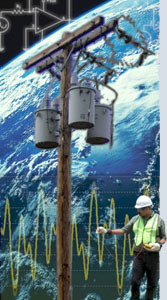Stray & Contact Voltage Research Facilities
Stray and contact voltage has been and continues to be a relentless unintended consequence of distributing electricity. Newspapers are quick to report and sensationalize stories about people being shocked and even electrocuted by it. Pets are especially vulnerable to contact voltages because they don’t have the protection that shoes typically afford. Because contact and stray voltages are invisible, inaudible, and inodorous, they easily lurk. Underground wires spread below densely populated areas like roots in a forest, now and then surfacing and touching metallic objects near pedestrians. Dairy cows provide low yields (or, worse, die) because milking machines or watering troughs have been touched by electrical conductors. Swimmers complain of tingling in their pools, or a nearby fault causes lethal voltage potential between the water and the deck ladder.
EPRI has been investigating the causes and consequences of stray and contact voltages for decades. The research team assigned to this area has amassed a suite of research facilities, tools, methods, and knowledge to address the ugly potential of unintentionally electrified objects to do harm and expose electric utilities to high liabilities (collectively called the “EPRI Stray & Contact Voltage Project”). The achievements of this team include:
- Conducting laboratory research. When it comes to unbiased research, EPRI has placed its stake in the ground. Achievements of the Contact/Stray Voltage Team include groundbreaking research at the EPRI Lennox Laboratory.
- Informing and influencing standards, regulations, codes, and trade associations. Researchers promulgate and promote leading practices, such as how to properly ground and bond swimming pools to maximize the safety of humans and their pets.
- Informing electric utilities, trade workers, and the public. Team members attend and present at influential national conferences, conduct workshops, and train utility and trade workers.
- Conducting field investigations. Field investigations that result in actionable recommendations save lives.
- Building a wealth of knowledge. The outcomes of research, testing, field investigations, and dialogue with industry lead to new knowledge and technology transfer to those who make public safety their concern.
- Working with industry. Industry is coming around to the notion that protecting the public from stray and contact voltages could be lucrative as well as socially responsible.
Conducting Laboratory Research
The EPRI Lenox Stray and Contact Voltage Test Laboratory in Massachusetts consists of two test areas. The Stray and Contact Voltage Test Area for Mobile Sensors enables researchers to test the viability of sensors (prototypes as well as sensors already on the market) whose manufacturers claim can detect stray and contact voltages from a mobile platform, such as a passenger vehicle. The goal is to help industry develop mobile detection devices that can accompany utility workers in their vehicles as they safely search for and rectify cases of contact and stray voltages, especially in urban areas. The Swimming Pool Test Area enables researchers to test different configurations of pool bonding and grounding to determine their levels of safety, as well as test various pool safety devices and techniques. This is no ordinary pool.

Stray and Contact Voltage Test Area for Mobile Sensors
Consistent and repeatable testing is a challenge for any laboratory. Testing the performance of a device in motion doubles that challenge. The Contact/Stray Voltage Team rose to the challenge by designing a system around an existing dirt road. As shown below, means for electrifying a metallic object (such as a fire hydrant, a fence, a manhole cover, a gas line cover, a metal grate, or a light pole) were installed to the right of the road. Means to “confuse” the tested mobile detector with a strong magnetic field were also introduced into the test area. During tests, the mobile platform—typically a passenger vehicle—travels along the paved road while the stray/contact voltage detector operates. Data from the sensor can be immediately analyzed by researchers in the field, enabling manufacturers of detectors to improve their products and fostering innovation.

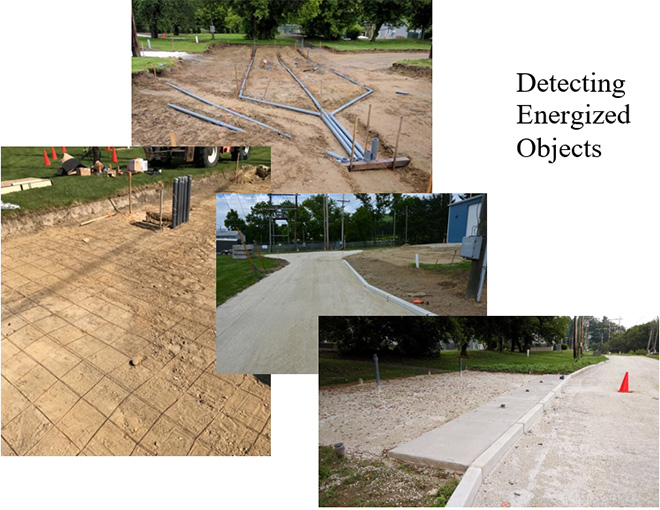
The mobile platform may be a human operator carrying a handheld detector, such as the ones shown below. The prime objective of these handheld devices is to provide a means of remote detection of stray and contact voltages to ensure the safety of the utility investigator. With innovations in antenna design and electronics, investigators can identify objects in their surroundings that have been unintentionally energized and therefore pose a risk to the public.

Swimming Pool Test Area
Elevated contact voltages can be caused by several electrical phenomena. Faults—on either the customer side of the service transformer or the distribution side—may lead to momentary but excessive contact voltages at residences affected by the fault. An elevated potential between the neutral conductor and earth can cause a steady-state excessive voltage at a pool area. The Contact/Stray Voltage Team needed a way to test the various bonding and grounding methods to determine the best way to ensure the safety of not only pool swimmers but people and pets at marinas, boat docks, and other recreational areas near bodies of water.
Again, researchers were faced with the challenge of conducting consistent and repeatable testing. The pool at the Swimming Pool Test Area of the EPRI Lenox Laboratory was designed for maximum testing flexibility.
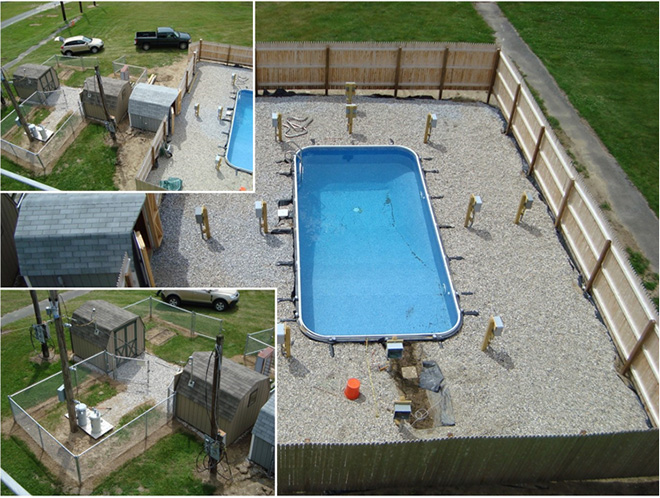
The shell of the pool is composed of a non-conductive composite of plastic and fiberglass, with a vinyl liner on the inside of the shell. This type of pool represents a worst-case scenario for shock and perception complaints. The simulated residential swimming pool infrastructure contains multiple knife switches to dynamically control the conductive components of the pool area. This building also contains an autotransformer, which is used to create elevated voltages from the neutral conductor to ground. A diverse selection of bonding rings, bonding grids, ground rods and ground rings have been installed and are disconnectable during the testing to better understand each component’s respective role in mitigating shock hazards.
The five unique deck configurations that were constructed at the Lenox Lab are:
- A concrete deck with a copper equipotential grid contained in the concrete and composed of 8-AWG bare conductors bonded to each other at all points of crossing. This (12 inch by 12 inch) network of conductors conforms to the contour of the pool and extends under the walking surfaces three feet from the inside walls of the pool. This enables researchers to test the performance of the NEC Article 680 (alternate means) that was removed from the code in the 2008 revision with no test justification.
- A concrete deck without an equipotential grid but with a perimeter equipotential bonding ring that complies with the “alternate means” of equipotential bonding described in NEC Article 680. Specifically, an 8-AWG bare, solid-copper conductor is buried six inches below subgrade around the perimeter of the pool at 18 inches from the pool side.
- A concrete deck with a steel equipotential grid contained in the concrete The conductors of the grid are arranged in a 6-inch by 6-inch network with a uniformly spaced perpendicular grid pattern. This enables researchers to test the performance of steel versus copper and to compare the performance of 6 x 6 versus 12x 12 inch grid geometries.
- A concrete deck without an equipotential grid. Instead of the grid, this deck area contains a perimeter equipotential bonding ring that complies with the “alternate means” described in NEC Article 680.26 - 2017. Specifically, an 8-AWG bare, solid-copper conductor is buried six inches below subgrade around the perimeter of the pool at 18 inches from the inside pool wall.
- 4. A decorative paver deck without an equipotential grid. Instead of the grid, this deck area contains a perimeter equipotential bonding ring that complies with the “alternate means” described in NEC Article 680.26 - 2017. Specifically, an 8-AWG bare, solid-copper conductor is buried six inches below subgrade around the perimeter of the pool at 18 inches from the inside pool wall. The enables researchers to understand if there are differences in shock a perception hazards for paver decks versus poured concrete decks.
- 5. A concrete deck without any equipotential bonding means. The only equipotential bonding means is a solid bare copper conductor that interconnect all the metal parts around the pool such as the light niches, the metal ladders and the metal handrails. This area provides a baseline for the shock hazard when no equipotential wires or grids have been installed within or under the decking area. The area additionally serves to understand the performance of rubber deck coatings and other retrofit ideas.
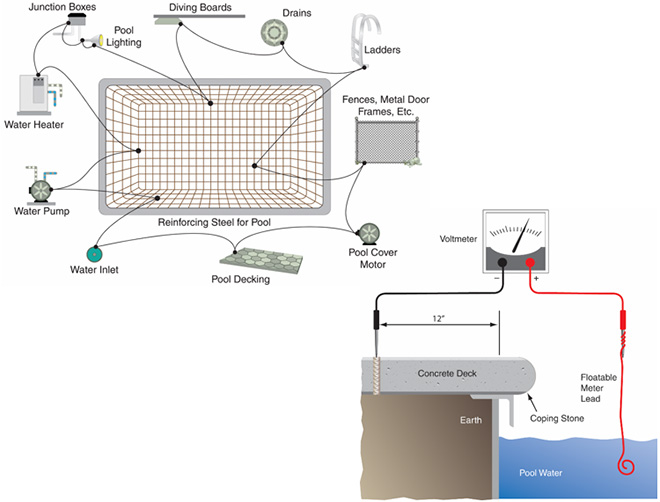
Note: The configurations described above do not perform equally and various states (for example Massachusetts) have initiated legislation to disallow the NEC alternate means of single bare copper equipotential bonding ring.
Informing and Influencing Standards, Regulations, Codes, and Trade Associations
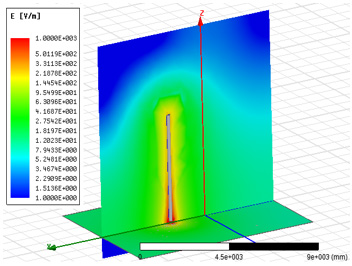
EPRI is informing methods for testing detection and mitigation technologies so that specifiers and installers can be confident that the products have been properly applied in the field. Because there is no unified voice for “safe” levels of contact voltages, the Stray/Contact Voltage Team monitors and informs the works of standards-making bodies, such as UL, ANSI/IEEE, IEC, NFPA, OSHA, NESC, NEC, and NACE. The Contact/Stray Voltage Team aims to inform and influence not only these standards but also federal, state, and local codes. The Team also works with trade associations to enable them to communicate safety messages to their members, such as safe construction practices.
Informing Electric Utilities, Trade Workers, and the Public
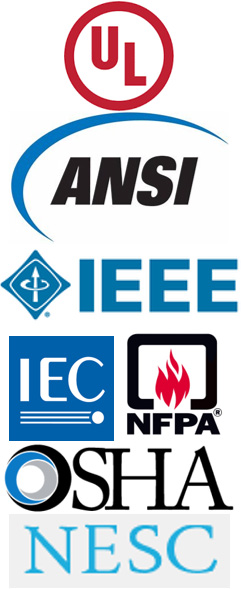
The Team shares new knowledge with utilities, standards-making bodies, governments, trade workers, and the public. EPRI speaks with authority and research results to back up its recommendations. The Team trains investigators on the latest equipment and diagnostics approaches and installation practices. The Team disseminates public-service materials, such as increasing awareness of voltage levels of concern and limits, requirements for new codes, test protocols, and general guidance on the subject matter.
EPRI also developed a process and technology roadmap that has been leveraged for the past two decades to systematically address industry gaps with new technology R&D and industry publications. The Team managed the development of a publicly available EPRI guidebook for evaluating contact voltages around water bodies (1695-2016 - IEEE Guide to Understanding, Diagnosing, and Mitigating Stray and Contact Voltage). The document forms the basis for the evaluations of wet areas found in the recently published IEEE 1695-2016 - Guide to Understanding, Diagnosing, and Mitigating Stray and Contact Voltage. The Team continues to work toward revisions to the National Electrical Code (NEC) that are designed to make swimming pools and other water bodies electrically safe for the public.
Finally, the Team has co-facilitated with Consolidated Edison on the annual Jodie Lane National Conference for Stray and Contact Voltage for the past 14 years. This conference is the premier event for those involved in combating stray and contact voltage.
Conducting Field Investigations
The Team investigates contact and stray voltage complaints in urban areas and on farms, but investigating cases around bodies of water presents very unique diagnostic challenges. Using cutting-edge detection and diagnostic equipment—some of the Team’s own making—the Team assists utilities and governments to not only resolve problems related to stray and contact voltages but also prevent them.
Building a Wealth of Knowledge

In addition to a case-study library, meetings, webcasts, and conferences, the wealth of knowledge developed by the Team is imparted to concerned people through high-profile publications, a few of which are listed here:
- IEEE PES 2009 Publication: D. Dorr, Determining Voltage Levels of Concern for Human and Animal Response to AC Current
- EPRI 1020096: Guidebook for Evaluating Elevated Neutral-to-Earth and Contact Voltages in Distribution Systems
- EPRI 1022003: Stray and Contact Voltage Advancements in Measurement and Diagnostics Distribution Systems
- EPRI 3002001301: Integrated Technology for Distribution Systems Applications - Survey and Testing of Voltage Detecting/Indicating Devices for AC Power Lines
- EPRI 3002003885: PQ Encyclopedia, “Chapter 18: Understanding Stray and Contact Voltage”
- EPRI 3002005577: Detection of Electrically Energized Objects: Compendium of the 2011-2013 Consolidated Edison-EPRI Research Program
- EPRI 3002013204: PQ TechWatch – “Methods to Validate Systems That Detect Inadvertently Energized Objects: Understanding and Applying IEEE 1695”
- EPRI 3002003885: PQ Encyclopedia, “Chapter 18: Understanding Stray and Contact Voltage”
- EPRI 1018838: PQ Hotline Call of the Month – “July 2007: Elevated Voltage on a Gas Pipeline”
- EPRI 1025416: Advanced Sensing and Algorithms for Power Distribution Systems: Public and Worker Safety Related Topics
- EPRI 1012439: Assessment of Elevated Neutral to Earth Voltages in Distribution Systems – Modeling and Simulation Guidelines
Working with Industry
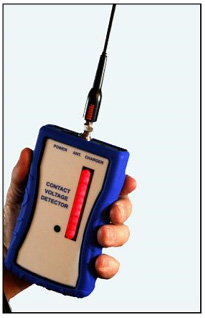
In addition to a case-study library, meetings, webcasts, and conferences, the wealth of knowledge developed by the Team is imparted to concerned people through high-profile publications, a few of which are listed here:
- IEEE PES 2009 Publication: D. Dorr, Determining Voltage Levels of Concern for Human and Animal Response to AC Current
- EPRI 1020096: Guidebook for Evaluating Elevated Neutral-to-Earth and Contact Voltages in Distribution Systems
- EPRI 1022003: Stray and Contact Voltage Advancements in Measurement and Diagnostics Distribution Systems
